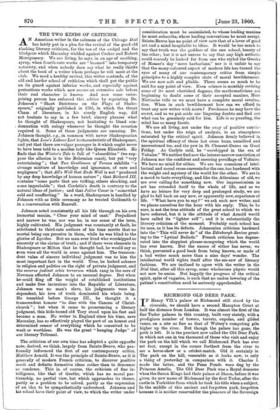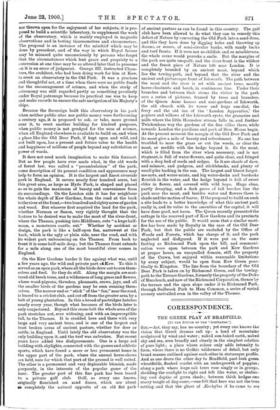RICHMOND OLD DEER PARK.
IF Hera"- VII.'s palace at Richmond still stood by the riverside, we should have a second Hampton Court at half the distance from London. It was almost the first of the fine Tudor palaces in this country, built very stately, with a prodigious number of towers, turrets, cupolas, and gilded vanes, on a site as fine as that of Wolsey's competing pile higher up the river. But though the palace has gone, the park is left. It is the precinct now called the Old Deer Park, in which not one in ten thousand of those who visit and enjoy the park on the hill which we call Richmond Park has ever set foot, except in the corner furthest from the river to see a horse-show or a cricket-match. Old it certainly is. The park on the hill, venerable as it looks now, is only a thing of yesterday in comparison with it. Charles I. made the latter, and the Penn Ponds were dug by the Princess Amelia. The Old Deer Park was a Royal demesne when the Saxon Kings had their palace at Sheen, before it was given its new name of Richmond by the first Tudor, after the castle in Yorkshire from which he took his title when a subject. In the middle of this ancient and forgotten park, forgotten because it is neither reserved for the pleasure of the Sovereign
nor thrown open for the enjoyment of her subjects, it is pro- posed to build a scientific laboratory, to supplement the work of the observatory, which is mainly employed in magnetic observations and in testing thermometers and chronometers. The proposal is an instance of the mischief which may be done by precedent, and of the way in which Royal favour may be misused quite unconsciously by persons who forget that the circumstances which lent grace and propriety to a concession at one time may be so altered later that to presume on it is an error of judgment. George III. instructed Cham- bers, the architect, who had been doing work for him at Kew, to erect an observatory in the Old Park. It was a gracious and thoughtful act, at a time when there were no public funds for the encouragement of science, and when the study of astronomy was still regarded partly as something peculiarly under Royal patronage because its practical use was to keep and make records to ensure the safe navigation of his Majesty's ships.
Because the Sovereign built this observatory in his park when neither public sites nor public money were forthcoming a century ago, it is proposed to ask, or take, more ground near it, to erect another building for kindred purposes, when public money is not grudged for the uses of science, when all England elsewhere is available to build on, and when a place like the Old Deer Park, if kept open and wild, and not built upon, has a present and future value to the health and happiness of millions of people beyond any calculation or power of words.
It does not need much imagination to make this forecast. But as few people have ever made what, in the old words of forest law, was called a "perambulation" of the park, some description of its present condition and appearance may help to form an opinion. It is the largest and finest riverside park in England. It covers nearly four hundred acres, but this great area, as large as Hyde Park, is shaped and placed so as to gain the maximum of beauty and convenience from its surroundings. On the London side it has for neighbour the whole depth of Kew Gardens, from the road at the back to the river at the front,—two hundred and eighty acres of garden and wood. But whoever first acquired the land for the park, whether Norman or Saxon, very rightly thought that the feature to be desired was to make the most of the river-front, where the Thames, pushing into Middlesex, cuts " a huge half- moon, a monstrous cantle, out." Whether by accident or design, the park is like a half-open fan, narrowest at the back, which is the ugly or plain side, near the road, and with its widest part unbosoming on the Thames. From back to front it is some half-mile deep; but the Thames front extends for a mile along one of the most beautiful river scenes in England.
On the Kew Gardens border it lies against what was, until a few years ago, the wild and private part of Kew. To this it served as an open park, where all the birds drew out to sun them- selves and feed. So they do still. Along the margin are scat- tered old beech trees, and a wilderness of long grass and flowers where wood-pigeons, thrushes, pheasants, crows, jays, and all the smaller birds of the gardens may be seen sunning them- selves. The narrow end or " stick " of the " fan," near the road, is leased to a cricket club, and cut off from the greater area by a belt of young plantation. In this a brood of partridges hatches nearly every year, though what becomes of the birds later is only conjectured. Beyond this cross-belt the whole area of the park stretches out, ever widening, and with an imperceptible fall, to the Thames. It is studded here and there with very large and very ancient trees, and is one of the largest and least broken areas of ancient pasture, whether for deer or cattle, in England. Until lately the old observatory was the only building upon it, and the turf was unbroken. But recent year have added two disfigurements. One is a large red building with skylights, connected with the games and athletic sports, which have found a more or less permanent home in the upper part of the park, where the annual horse-shows are held, uses for which that part of the ground is well suited. The other is a permanent and very deplorable blemish, made purposely, in the interests of the popular game of the hour. The greater part of this fine park has been leased to a private golf club. Golf, as every one knows, originally flourished on sand dunes, which are about as completely the natural opposite of an old flat park of ancient pasture as can be found in this country. The golf club have been allowed to do what they can to remedy this defect of Nature by converting the Old Park into a sand dune, and this they have done by digging holes and throwing up dozens, or scores, of semi-circular banks, with Bandy backs and turf fronts. If it were not so childish and so mischievous, the whole scene would provoke a smile. But the margins of the park are quite unspoilt, and the river-front is the wildest and the freest piece of Nature left near London. It is completely bounded by an ancient moat, beyond which lies the towing-path, and beyond that the river and the ancient and picturesque front of Isleworth. The path between the moat and the river is set with ancient trees, mostly horse-chestnuts and beech, in continuous line. Under their branches and between their stems the visitor in the park sees a series of pictures, framed by trees and branches, of the Queen Anne houses and rose-gardens of Isleworth, the old church with its tower and huge sun-dial, the ferry and the old inn of the ' London Apprentice,' the poplars and willows of the Isleworth eyots, the granaries and mills where the little Hounslow stream falls in, and further Twickenham way the gardens of the fine villas there, while towards London the pavilions and park of Sion House begin. At the present moment the margin of the Old Deer Park and its moat give a mile of beauty and refreshment. No one has troubled to mow the grass or cut the weeds, or clear the moat, or meddle with the hedge beyond it. So the moat, which is filled from the river when necessary, and is not stagnant, is full of water-flowers, and quite clear, and fringed with a deep bed of reeds and sedges. In it are shoals of dace, and minnow, and gudgeon, and sticklebacks, and plenty of small pike basking in the sun. The largest and bluest forget- me-nots, and water-mints, and big water-docks and burdocks flourish in the water, and the hedge beyond is full of sweet elder in flower, and covered with wild hops. Huge elms, partly decaying, and a dark grove of tall beeches line the park near the moat, and besides water and flowers there is shade and the motion of leaves. If the proposal to build on such a site leads to a better knowledge of what this ancient park really is, and its value to the amenities of the capital, it will have done good, not harm. The Queen recently presented the cottage in the reserved part of Kew Gardens and its precincts for the use of the public. It would seem that a similar sacri- fice has been made by Royalty in the case of the Old • Deer Park, but that the public are excluded by the Office of Woods and Forests, which has charge of it, and the park neglected and disfigured. If it were put on the same footing as Richmond Park upon the hill, and communi- cation were open between the park and Kew Gardena at proper hours, an unequalled domain, still the property of the Crown, but enjoyed within reasonable limitations by every subject, would be open from Kew Green prac- tically to Kingston. The line from the boundary of the Old Deer Park is taken on by Richmond Green, and the towing- path to the Terrace Gardens, formerly the property of the Duke of Buccleuch, and now of the Richmond Corporation, thence by the terrace and the open slope under it to Richmond Park, through Sudbrook Park to Ham Common, a series of varied scenery unrivalled even in the valley of the Thames.



































 Previous page
Previous page